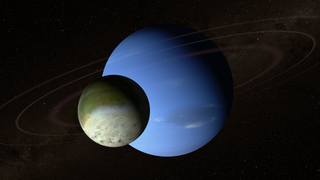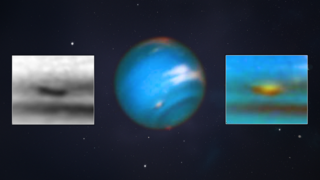Planets and Moons
Universe
ID: 4559
The Kepler spacecraft, launched in March of 2009, is a telescope designed to search for exoplanets, planets orbiting stars other than our sun. It does this by continuously measuring the brightness of over 100,000 stars, waiting for momentary dimming that might indicate a planet has crossed in front of its host star. Scientists can infer the size and orbital period of an exoplanet from the depth and frequency of such dips in the star's light curve.
For the first four years of the mission, Kepler stared at a single 12° patch of the sky between the bright stars Deneb, in the constellation Cygnus, and Vega, in Lyra, where it found several thousand exoplanet candidates. But when the second of the spacecraft's four reaction wheels failed in 2013, Kepler was no longer able to point accurately at its original target, so scientists devised a new way to point the spacecraft using the remaining two reaction wheels and photon pressure from sunlight. The new mission was dubbed K2.
Because of the new pointing method, K2 is limited to looking at fields along the plane of our solar system, but this also offers new ways to use the telescope's sensitive detectors. From November 2014 to January 2015, Kepler's field included the planet Neptune. Amy Simon, a planetary scientist at NASA’s Goddard Space Flight Center, looked for the faint signal of moving clouds embedded within Neptune's light curve.
Kepler is in an Earth-trailing heliocentric orbit, which just means that it's in orbit around the Sun and lagging behind the Earth, falling behind at the rate of 7.3 days per year. At the time of the Neptune observations, the spacecraft was trailing the Earth by about 6 weeks, or a little over 100 million kilometers. From this orbit, the K2 mission has identified hundreds of new exoplanet candidates.

Kepler Stares at Neptune
For the first four years of the mission, Kepler stared at a single 12° patch of the sky between the bright stars Deneb, in the constellation Cygnus, and Vega, in Lyra, where it found several thousand exoplanet candidates. But when the second of the spacecraft's four reaction wheels failed in 2013, Kepler was no longer able to point accurately at its original target, so scientists devised a new way to point the spacecraft using the remaining two reaction wheels and photon pressure from sunlight. The new mission was dubbed K2.
Because of the new pointing method, K2 is limited to looking at fields along the plane of our solar system, but this also offers new ways to use the telescope's sensitive detectors. From November 2014 to January 2015, Kepler's field included the planet Neptune. Amy Simon, a planetary scientist at NASA’s Goddard Space Flight Center, looked for the faint signal of moving clouds embedded within Neptune's light curve.
The Kepler observations are unique,said Simon,
because they allow us to see the light curve of an object close enough to image and resolve cloud features. These observations prove that rapid variations in light curves of brown dwarfs and exoplanets can be caused by changing clouds.
Kepler is in an Earth-trailing heliocentric orbit, which just means that it's in orbit around the Sun and lagging behind the Earth, falling behind at the rate of 7.3 days per year. At the time of the Neptune observations, the spacecraft was trailing the Earth by about 6 weeks, or a little over 100 million kilometers. From this orbit, the K2 mission has identified hundreds of new exoplanet candidates.

Used Elsewhere In
Related
For More Information
Visualization Credits
Ernie Wright (USRA): Lead Visualizer
Dan Gallagher (USRA): Producer
Amy A. Simon (NASA/GSFC): Scientist
Dan Gallagher (USRA): Narrator
Elizabeth Zubritsky (ADNET): Support
Nancy Neal-Jones (NASA/GSFC): Public Affairs Officer
Michele Johnson (NASA/ARC): Public Affairs Officer
Scott Wiessinger (USRA): Graphics
Tunç Tezel (The World at Night): Astrophotographer
Paul Schenk (Lunar and Planetary Institute): Image Processing
Björn Jónsson (The Planetary Society): Image Processing
Dan Gallagher (USRA): Producer
Amy A. Simon (NASA/GSFC): Scientist
Dan Gallagher (USRA): Narrator
Elizabeth Zubritsky (ADNET): Support
Nancy Neal-Jones (NASA/GSFC): Public Affairs Officer
Michele Johnson (NASA/ARC): Public Affairs Officer
Scott Wiessinger (USRA): Graphics
Tunç Tezel (The World at Night): Astrophotographer
Paul Schenk (Lunar and Planetary Institute): Image Processing
Björn Jónsson (The Planetary Society): Image Processing
Please give credit for this item to:
NASA's Scientific Visualization Studio
NASA's Scientific Visualization Studio
Science Paper:
A. Simon et al.,
Short URL to share this page:
https://svs.gsfc.nasa.gov/4559
Mission:
Kepler
Data Used:
Note: While we identify the data sets used in these visualizations, we do not store any further details nor the data sets themselves on our site.
This item is part of this series:
Narrated Movies
Keywords:
SVS >> HDTV
SVS >> Hyperwall
SVS >> Solar System
SVS >> Planets
SVS >> Constellation
SVS >> Astronomy
SVS >> Planetary Science
SVS >> Neptune
NASA Science >> Planets and Moons
NASA Science >> Universe
SVS >> Exoplanet
SVS >> Telescope
SVS >> Kepler
A. Simon et al.,
Neptune's Dynamic Atmosphere from Kepler K2 Observations: Implications for Brown Dwarf Light Curve Analyses,The Astrophysical Journal, 817:162 (Feb 1, 2016)
Short URL to share this page:
https://svs.gsfc.nasa.gov/4559
Mission:
Kepler
Data Used:
U.S. Naval Observatory/Third CCD Astrograph/Catalog also referred to as: UCAC3
Database - USNOJPL DE421 also referred to as: DE421
Ephemeris - NASA/JPL
Planetary ephemerides
Kepler
NASA - 2014 Nov 14 - 2015 Feb 3 (K2 Campaign 3)This item is part of this series:
Narrated Movies
Keywords:
SVS >> HDTV
SVS >> Hyperwall
SVS >> Solar System
SVS >> Planets
SVS >> Constellation
SVS >> Astronomy
SVS >> Planetary Science
SVS >> Neptune
NASA Science >> Planets and Moons
NASA Science >> Universe
SVS >> Exoplanet
SVS >> Telescope
SVS >> Kepler













